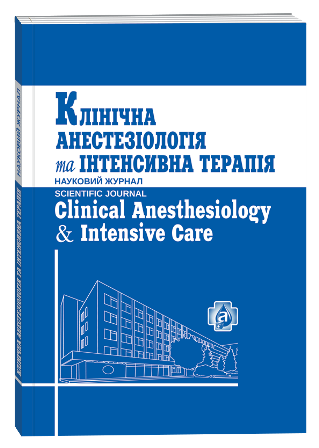OBESE PATIENTS: ANESTHETIC CHALLENGES
DOI:
https://doi.org/10.31379/2411.2616.11.1.1Keywords:
obesity, anesthetic, pathophysiologyAbstract
In the age of the worldwide obesity epidemic, the obese patient is commonly encountered by the anesthesiologist. The anatomical distribution of increased body fat has numerous pathophysiologic consequences, especially as it pertains to the cardiopulmonary system. These changes may directly impact the perioperative course and must be appreciated. Obesity is associated with numerous co-morbidities, and special attention must be made to obtaining a thorough history and physical examination prior to surgery. In this chapter, we review important consideration for providing safe anesthesia to the obese patient. The physiologic effects of obesity are discussed, as well as important preoperative, intraoperative, and postoperative concerns.
References
Koenig S. M. Pulmonary complications of obesity. Am J Med Sci. 2001. № 321. P. 249–279.
Murugan A. T., Sharma G. Obesity and respiratory diseases. Chron Respir Dis. 2008. № 5. P. 233–242.
Cardiovascular evaluation and management of severely obese patients undergoing surgery: a science advisory from the American Heart Association / P. Poirier et al. Circulation. 2009. № 120. P. 86–95.
Barash P. G. Clinical anesthesia. 6th ed. Philadelphia: Wolters Kluwer/Lippincott Williams & Wilkins. 2009. № 34. P. 65.
Kokkoris P., Pi-Sunyer F. X. Obesity and endocrine disease. Endocrinol Metab Clin North Am. 2003. № 32. P. 895–914.
Douyon L., Schteingart D. E. Effect of obesity and starvation on thyroid hormone, growth hormone, and cortisol secretion. Endocrinol Metab Clin North Am. 2002. № 31. P. 173–189.
Prevalence of subclinical hypothyroidism in a morbidly obese population and improvement after weight loss induced by Roux-en-Y gastric bypass / C. M. Moulin de Moraes et al. Obes Surg. 2005. № 15. P. 1287–1291.
Reinehr T., Andler W. Thyroid hormones before and after weight loss in obesity. Arch Dis Child. 2002. № 87. P. 320–323.
Rosenberg D. E., Jabbour S. A., Goldstein B. J. Insulin resistance, diabetes and cardiovascular risk: approaches to treatment. Diabetes Obes Metab. 2005. № 7. P. 642–653.
Obesity and estrogen as risk factors for gastroesophageal reflux symptoms / M. Nilsson et al. JAMA. 2003. № 290. P. 66–72.
Hepatic decompensation after gastric bypass surgery for severe obesity / S. J. Cotler et al. Dig Dis Sci. 2004. № 49. P. 1563–1568.
Modest weight loss and physical activity in overweight patients with chronic liver disease results in sustained improvements in alanine aminotransferase, fasting insulin, and quality of life / I. J. Hickman et al. Gut. 2004. № 53. P. 413–419.
The effects of weight loss on renal function in patients with severe obesity / A. Chagnac et al. J Am Soc Nephro. 2003. № 14. P. 1480–1486.
Glomerular hemodynamics in severe obesity / A. Chagnac et al. Am J Physiol Renal Physiol. 2000. № 278. P. 817–822.
Hall J. E. The kidney, hypertension, and obesity. Hypertension. 2003. № 41. P. 625–633.
Obesity and laparoscopic repair of ventral hernias / G. Birgisson et al. Surg Endosc. 2001. № 15. P. 1419.
Outcomes of laparoscopic donor nephrectomy in obese patients / P. C. Kuo et al. Transplantation. 2000. № 69. P. 180–182.
Anesthetic management of morbidly obese and super-morbidly obese patients undergoing bariatric operations: hospital course and outcomes / Y. Leykin et al. Obes Surg. 2006. № 16. P. 1563–1569.
Neligan P. J. Metabolic syndrome: anesthesia for morbid obesity. Curr Opin Anaesthesiol. 2010. № 23. P. 375–383.
Unrecognized sleep apnea in the surgical patient: implications for the perioperative setting / R. Kaw et al.. Chest. 2006. № 129. P. 198–205.
The obesity-hypoventilation syndrome revisited: a prospective study of 34 consecutive cases / R. Kessler et al. Chest. 2001. № 120. P. 369–376.
Isono S. Obesity and obstructive sleep apnoea: mechanisms for increased collapsibility of the passive pharyngeal airway. Respirology. 2012. № 17. P. 32–42.
Isono S. Obstructive sleep apnea of obese adults: pathophysiology and perioperative airway management. Anesthesiology. 2009. № 110. P. 908–921.
O’Keeffe T., Patterson E. J. Evidence supporting routine polysomnography before bariatric surgery. Obes Surg. 2004. № 14. P. 23–26.
Lopez P. P., Stefan B., Schulman C. I., Byers P. M. Prevalence of sleep apnea in morbidly obese patients who presented for weight loss surgery evaluation: more evidence for routine screening for obstructive sleep apnea before weight loss surgery. Am Surg. 2008. № 74. P. 834–838.
A prospective study of age and lifestyle factors in relation to community-acquired pneumonia in US men and women / I. Baik et al. Arch Intern Med. 2000. № 160. P. 3082–3088.







